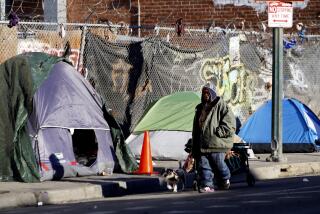Study Looks at Roots of TB Among Homeless
A majority of tuberculosis cases among the homeless in Los Angeles result from new infections rather than the reactivation of an old, dormant infection, USC researchers report today.
The new results suggest that the number of TB cases among the homeless could be sharply reduced by measures to control the spread of the bacterium that causes the disease, Dr. Peter F. Barnes and his colleagues report in the Journal of the American Medical Assn.
The team identified 34 homeless individuals in central Los Angeles who developed TB between March 1993 and July 1994 and found that at least 18 were newly infected. Researchers had previously believed that only about 10% of TB cases among the homeless were of recent origin, as is the case in the population as a whole.
Surprisingly, the incidence of new cases of TB among these individuals was about the same as the incidence of new cases among AIDS patients, suggesting that alcoholism, malnutrition and substance abuse can sharply increase susceptibility to infectious diseases.
“There is more transmission going on among [homeless] adults than we thought,” said Dr. Paul Davidson of Los Angeles County’s TB Control Program. “But that transmission is isolated in high-risk groups and is not something that is going on in the general population,” he added.
In fact, the number of TB cases in Los Angeles County was down about 8% in 1995 from the 1,794 reported in 1994, he said. “We’ve been maintaining a downward trend from the peak [of 2,198 cases] in 1992.” There were 155 cases of TB among the homeless in the county in 1995, a 12% drop from the preceding year.
Barnes’ team identified all the TB patients at County-USC Medical Center and the Satellite Clinic in the downtown skid row area and found 39 who were homeless. Five were excluded from the study because they could not be located for an interview, or the bacteria that caused their disease could not be isolated.
Using sophisticated genetic engineering techniques, the researchers studied DNA from the tuberculosis bacteria isolated from each patient. Bacteria from 10 patients were from old infections rather than a current outbreak.
But among the remaining 24 patients, only six strains of bacteria were isolated, indicating that the infectious agent had recently been transmitted, most likely in homeless shelters. Assuming that one person in each cluster had a dormant infection that had reemerged, the team calculated that at least 18 of the patients had recent infections.
The findings are encouraging, Barnes said, because “we have a window of opportunity to stop TB spread.”
The most effective way to do that is to go into shelters and take X-rays of the homeless to identify those with active TB, he said, and then isolate and treat them.
“If we simply wait for them to come into hospitals when they are sick, they will already have infected a bunch of people,” he added.
It would also be helpful, he said, to install ultraviolet lights in shelters and other places where the homeless congregate because the light kills the TB bacteria in the air. The disease is transmitted primarily by airborne particles emitted during coughing spells, and such lights would limit its spread.
More to Read
Sign up for Essential California
The most important California stories and recommendations in your inbox every morning.
You may occasionally receive promotional content from the Los Angeles Times.






